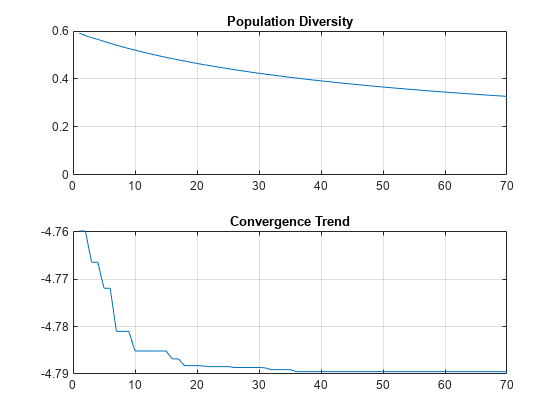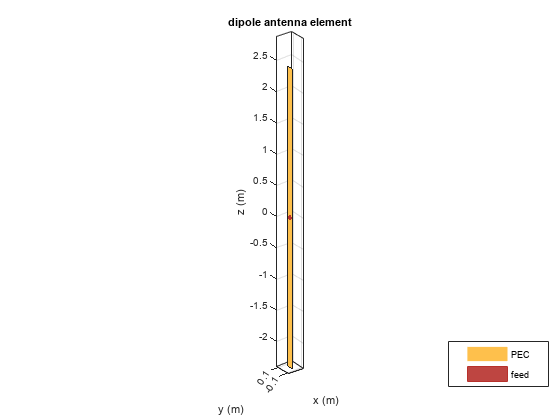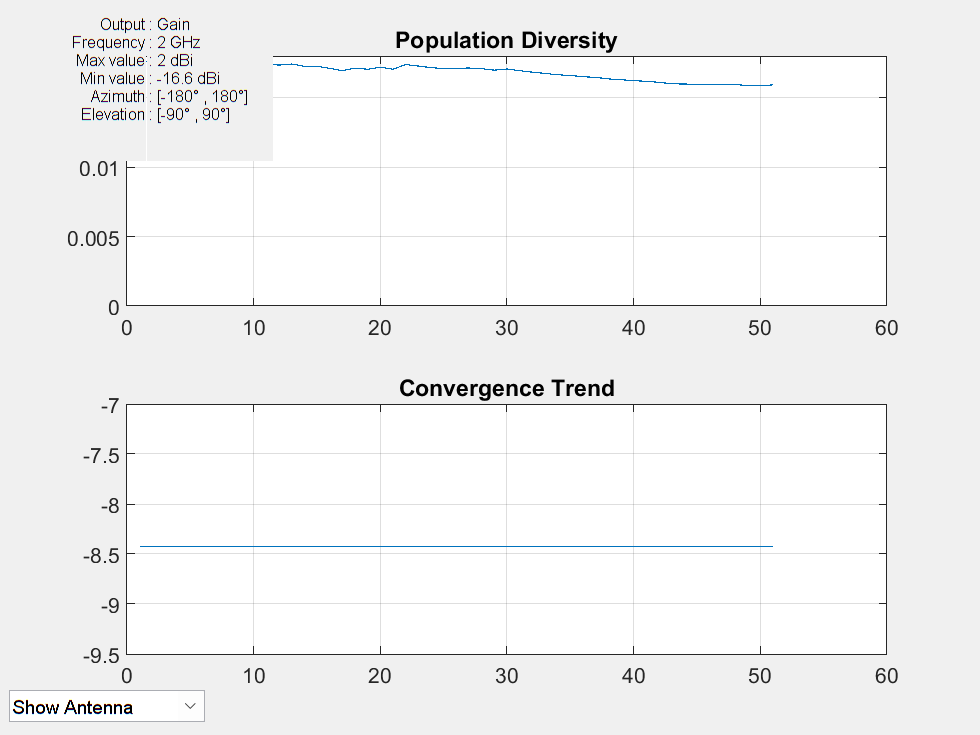optimize
Optimize antenna and array catalog elements using SADEA or TR-SADEA algorithm
Syntax
Description
optimizedelement = optimize(element,frequency,objectivefunction,propertynames,bounds)
optimizedelement = optimize(___,Name=Value)
Examples
Create and view a default dipole antenna.
ant = dipole; show(ant)

Maximize the gain of the antenna by changing the antenna length from 3 m to 7 m and the width from 0.11 m to 0.13 m.
Optimize the antenna at a frequency of 75 MHz.
optAnt = optimize(ant,75e6,"maximizeGain", ... {'Length','Width'}, {3 0.11; 7 0.13})

optAnt =
dipole with properties:
Length: 4.7979
Width: 0.1100
FeedOffset: 0
Conductor: [1×1 metal]
Tilt: 0
TiltAxis: [1 0 0]
Load: [1×1 lumpedElement]
show(optAnt)

This example shows how to optimize an E-Notch microstrip patch antenna for gain with constraints on its geometry.
Create E-Notch Microstrip Patch Antenna
Create an E-Notch microstrip patch antenna operating at 2GHz and vary its center arm notch length and width.
% Create E-notch microstrip antenna
ant = design(patchMicrostripEnotch,2e9);
ant.CenterArmNotchLength = 0.0073;
ant.CenterArmNotchWidth = 0.0144;Plot its radiation pattern and check the maximum gain value.
% Check the gain figure pattern(ant,2e9,Type="gain")

Optimize E-Notch Microstrip Patch Antenna for Gain
Define the design variables, and their lower and upper bounds.
designVariables = {'CenterArmNotchLength','NotchLength','Width','CenterArmNotchWidth','NotchWidth'};
XVmin = [0.001, 0.03, 0.03, 0.01, 0.001];
XVmax = [0.02, 0.06, 0.07, 0.03, 0.009];Add geometric constraints
Prepare coefficients in the form of a matrix with reference to below linear inequalities:
Rewrite the inequalities 1 & 2 in the form of
Convert these inequalities to a matrix of form , where is coefficient matrix and is constant matrix. Write the coefficients as per the order of design variables.
A = [5,-1,0,0,0;...
0,0,-1,1,2];
b = [0;0];Define a structure to contain both the coefficient and constant matrices.
constraintsStructure.A = A; constraintsStructure.b = b;
Optimize E-Notch microstrip patch antenna and check its gain
Run the optimization on E-Notch microstrip patch antenna leveraging these constraints. Visualize the optimized design and plot the radiation pattern.
optAnt = optimize(ant, 2e9, "maximizeGain", designVariables, {XVmin;XVmax}, Iterations=50, GeometricConstraints=constraintsStructure);
figure show(optAnt)

figure
pattern(optAnt,2e9,Type="gain")
Input Arguments
Antenna or array to optimize, specified as an antenna object from the antenna catalog, array object from the
array
catalog, or customAntenna object.
Note
To optimize pcbStack antenna, use PCB Antenna
Designer app.
Example: dipole
Example: linearArray(Element=dipole)
Example: customAntenna(Shape=shape.Rectangle)
Operating frequency of the antenna or array to optimize, specified as a positive scalar in Hertz.
Example: 70e6
Data Types: double
Objective of antenna or array optimization, specified as a string from one of the following:
maximizeGain— Maximize the gain of the given antenna or array elementfronttoBackRatio— Increase the front-lobe-to-back-lobe ratio of the antenna or array elementmaximizeBandwidth— Maximize the operation bandwidth of the antenna or array element. Use this objective function for optimizing antennas or arrays for wideband applications.minimizeBandwidth— Minimize the operation bandwidth of the antenna or array element. Use this objective function for optimizing antennas or arrays for narrowband applications.maximizeSLL— Maximize the ratio between the front lobe and the first side lobes of the antenna or array pattern.minimizeArea— Minimizes the maximum area occupied by the antenna or the array element. If the dimension of the element in the array is smaller than the aperture, the objective function minimizes the array aperture.Custom objective function — Optimizes the antenna or array as per the user defined objective function.
Anonymous function handle — Optimizes the antenna or array for the objectives defined using the anonymous function handle.
Data Types: string
Properties of the antenna or array object to optimize, specified as a cell array of character vectors. The property names are selected as the design variables in optimization.
Example: {'Length','Width'}
Data Types: cell
Lower and upper bounds of design variables, specified as a two-row cell array.
Example: {3 0.11; 7 0.13}
Data Types: double
Name-Value Arguments
Specify optional pairs of arguments as
Name1=Value1,...,NameN=ValueN, where Name is
the argument name and Value is the corresponding value.
Name-value arguments must appear after other arguments, but the order of the
pairs does not matter.
Example: Constraints={'Area < 0.03'}
Optimization constraints, specified as a cell array of strings or character vectors. Each character vector or string must be specified in the following format: (analysis function) (inequality sign) (value). You can specify any of the following analysis functions:
Areain meter squareVolumein meter cubeS11in dBGainin dBiF/Bin dBiSLLin dBi
The inequality signs '<' or '>' and the
values specifies the analysis function limits. For example, 'Area <
0.03' indicates that the area of the optimizing antenna must be less than
0.03 square meter.
Example: {'Area < 0.03'}
Data Types: char | string
Weight or penalty of each constraint function, specified as a vector of positive integers in the range (1,100). If the penalty is set to high, a higher priority is given to the constraint function in case of multiple constraint optimization. All constraint functions are weighted equally by default.
Example: 8
Data Types: double
Range of frequencies for vector frequency analysis like S-parameters, specified as a vector of positive numbers with each element unit in Hertz.
The default frequency range is obtained from the center frequency considering a bandwidth of less than 10 percent.
Example: linspace(1e9,2e9,10)
Data Types: double
Reference impedance of antenna or array being optimized, specified as a scalar in ohms.
Example: 75
Data Types: double
Azimuth and elevation of main lobe of antenna or array being optimized, specified as a two-element vector with each element unit in degrees. The first element represents azimuth and the second element represents elevation.
Example: [20 30]
Data Types: double
Number of iterations to run the optimizer after you build the model, specified as a positive scalar.
Example: 40
Data Types: double
Option to enable parallel pool, specified as a logical value. The default value is
false. Set this option to true to enable the
parallel pool. Use parallel pool to speed up the optimization for computationally
large antennas and arrays. To use this feature, you need a license to the Parallel Computing Toolbox™.
Use the canUseParallelPool function to check if Parallel Computing Toolbox is installed and licensed for use, a default parallel pool is configured
and supported, and automatic creation of parallel pools is enabled.
Example: true
Data Types: logical
Option to enable mutual coupling of elements in an array during optimization,
specified as a logical true to enable or false
to disable. By default, this option is enabled.
Example: false
Data Types: logical
Option to print iteration number and value of convergence on the command line,
specified as a logical true to enable or false
to disable. By default, this option is disabled.
Example: true
Data Types: logical
Geometric constraints for optimization, specified as a structure of coefficient matrix and constant vector.
Specify linear inequality constraints in the A matrix and b vector.
A is a real M-by-N matrix where M is the number of inequalities, and N is the number of design variables. A holds the design variable coefficients of the inequalities.
b is a real M-element column vector and holds the constants of inequalities corresponding to the coefficients in A.
For example, consider an optimization problem consisting of 5 design variables as follows:
designVariables = {'CenterArmNotchLength','NotchLength','Width',...
'CenterArmNotchWidth','NotchWidth'};5*CenterArmNotchLength - NotchLength < 0
CenterArmNotchWidth + 2*Notchwidth - Width < 0
Define the A and b as follows:
A = [5,-1,0,0,0;...
0,0,-1,1,2];
b = [0;0];Specify linear equality constraints in the Aeq matrix and beq vector.
Aeq is an Me-by-N matrix, where Me is the number of equalities, and N is the number of design variables. Aeq holds the design variable coefficients of the equalities.
beq is a real Me-element column vector and holds the constants of equalities corresponding to the coefficients in Aeq.
Specify non-linear inequality constraints in the nlcon matrix and nrlv vector.
nlcon is a function handle that defines nonlinear constraints. It stores the design variables.
nrlv is a 1-by-N vector of
0and1. N is the number of design variables in nlcon. Each index in nrlv corresponds to a design variable in nlcon in that sequence. Specify1at an index in nrlv to convey theoptimizefunction that the corresponding design variable is relevant for optimization. Specify0at an index in nrlv to convey theoptimizefunction that the corresponding design variable is not relevant for optimization.
For example, to maximize the gain of a dipole antenna operating at 75 MHz with constraints on its length and width, use this code:
optAnt = optimize(dipole, 75e6, "maximizeGain", {"Length", "Width"},...
{LowerBound; UpperBound}, Iterations=150, GeometricConstraints=opt);
opt =
struct with fields:
A: [100×2 double]
b: [100×1 double]
Aeq: [-1 5]
beq: 0
nlcon: @btw
nrlv: [1 1]For additional information on linear and nonlinear equalities and nonlinear
inequalities, see the fmincon (Optimization Toolbox) function documentation.
Example: A=[5,-1,0,0,0; 0,0,-1,1,2]; b=[0;0]; structure.A=A;
structure.b=b;
Example: Aeq=[-1 5]; beq=0; structure.Aeq=Aeq;
structure.beq=beq;
Example: nlcon=@btw; nrlv=[1 1]; structure.nlcon=nlcon;
structure.nrlv=nrlv;
Data Types: struct
Algorithm to use for antenna or array optimization, specified as a string. By
default, the optimize function uses SADEA algorithm. Use TR-SADEA
for applications where the evaluation of the objective function is computationally
expensive. For more information, see optimization
algorithms.
Example: UseAlgorithm="TR-SADEA"
Data Types: string
Output Arguments
Optimized antenna or array element, returned as an antenna, array, or
customAntenna object.
Version History
Introduced in R2020bThe optimize function has added three new features:
You can now use custom geometric constraints defined by linear equalities and
nonlinear inequalities for antenna or array optimization. Define the custom geometric
constraints in the GeometricConstraints property of the
optimize function using the opt structure that
contains the coefficients of linear inequalities (A, b) and equalities (Aeq, beq) and
nonlinear inequalities (nlcon, nrlv).
Optimize large antennas and arrays using the TR-SADEA algorithm in the
optimize function. Set the new UseAlgorithm
argument in the optimize function to "TR-SADEA" to
use TR-SADEA algorithm for your optimization task. To use this feature, you need a license
for Statistics and Machine Learning Toolbox™ in addition to
Antenna Toolbox™.
You can now use an anonymous function handle to define antenna or array optimization
objectives in the optimize function.
Specify a custom objective function to define antenna or array optimization objectives.
Use custom geometric constraints defined by linear inequalities of design variables for antenna or array optimization. Specify custom geometric constraints in the new
GeometricConstraintsname-value argument.
See Also
Functions
canUseParallelPool|fmincon(Optimization Toolbox)
Objects
Topics
- SADEA Optimization of Six-Element Yagi-Uda Antenna using Custom Objective Function
- Direct Search Based Optimization of Six-Element Yagi-Uda Antenna
- Surrogate Based Optimization of Six-Element Yagi-Uda Antenna
- Optimization of Antenna Array Elements Using Antenna Array Designer App
- Maximizing Gain and Improving Impedance Bandwidth of E-Patch Antenna
- Antenna and Array Optimization Algorithms
MATLAB Command
You clicked a link that corresponds to this MATLAB command:
Run the command by entering it in the MATLAB Command Window. Web browsers do not support MATLAB commands.
选择网站
选择网站以获取翻译的可用内容,以及查看当地活动和优惠。根据您的位置,我们建议您选择:。
您也可以从以下列表中选择网站:
如何获得最佳网站性能
选择中国网站(中文或英文)以获得最佳网站性能。其他 MathWorks 国家/地区网站并未针对您所在位置的访问进行优化。
美洲
- América Latina (Español)
- Canada (English)
- United States (English)
欧洲
- Belgium (English)
- Denmark (English)
- Deutschland (Deutsch)
- España (Español)
- Finland (English)
- France (Français)
- Ireland (English)
- Italia (Italiano)
- Luxembourg (English)
- Netherlands (English)
- Norway (English)
- Österreich (Deutsch)
- Portugal (English)
- Sweden (English)
- Switzerland
- United Kingdom (English)